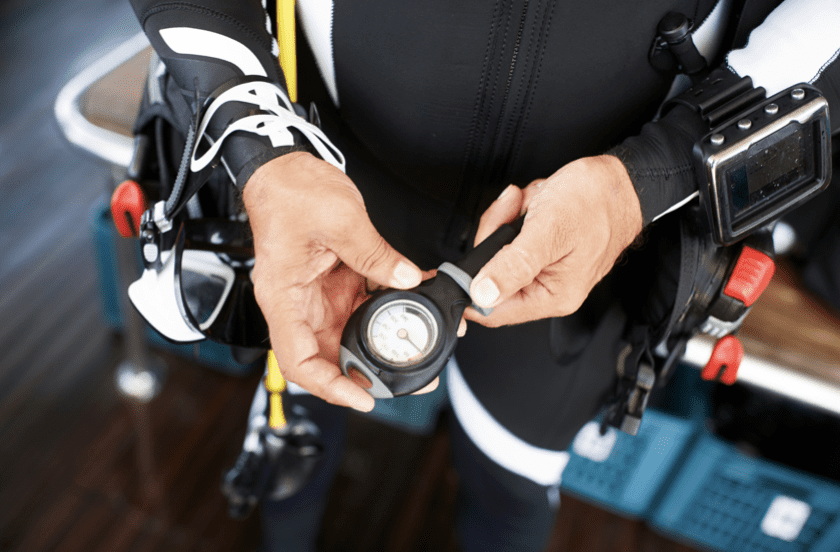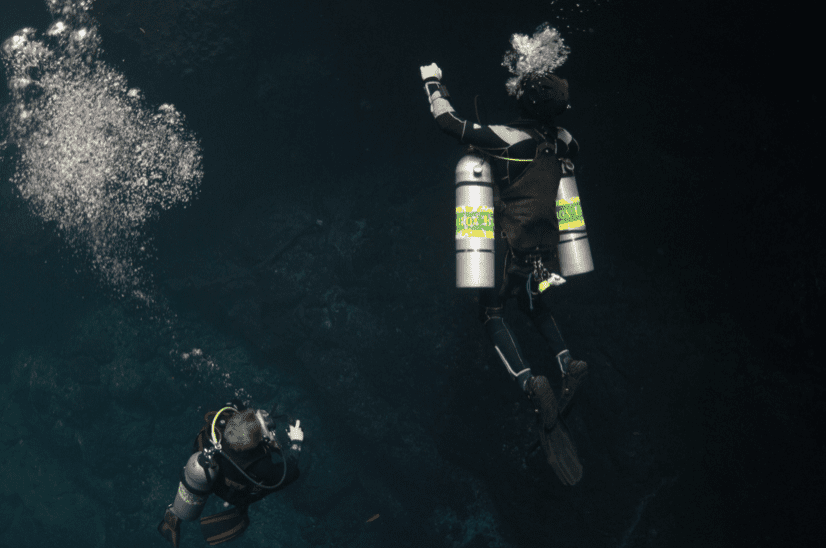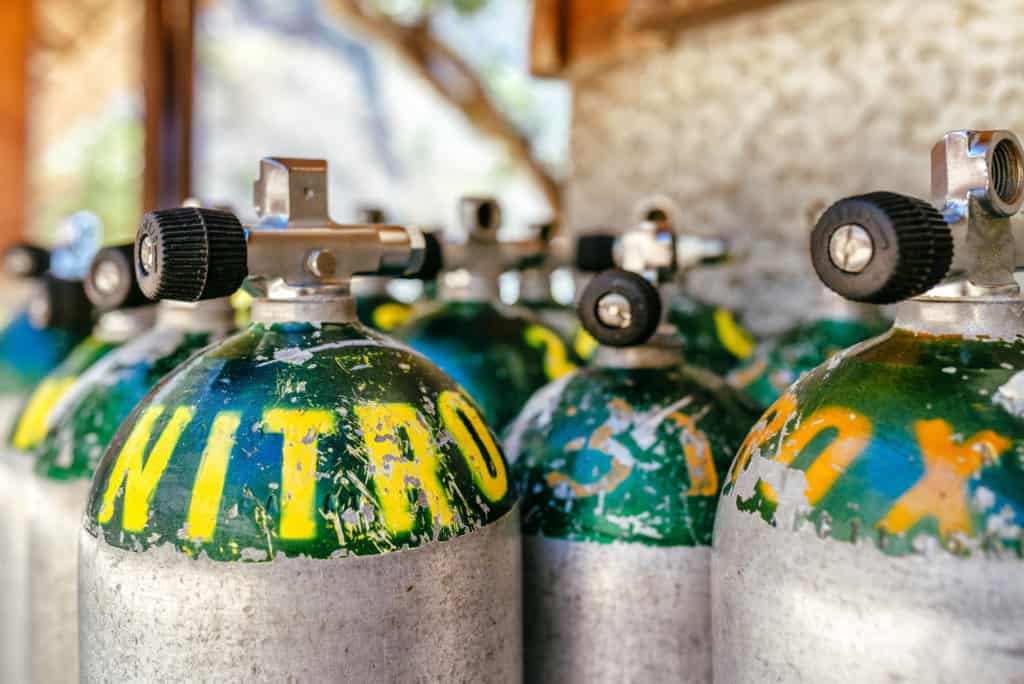As scuba divers, we use a tank of air to breathe bubbles beneath the ocean, but what if that mix isn’t just air? Welcome to the world of Nitrox diving – an oxygen-enriched air mix that can increase your dive time! Find out why the Nitrox course is so popular with divers.
Scuba Diving Nitrox Certification – PADIs Most Taught Specialty Diver Course
You will have likely been on a dive boat at some point and spotted the different yellow and green tanks that show a diver is using a different type of gas blend.
These tanks contain oxygen-enriched air, EAN, EANx or “nitrox” for short. This gas mix has been used in Scuba for many, many years, with the main benefit being that it increases your no stop dive time. This gives you longer dive immersions and shorter surface intervals!
But nitrox is a tool that also has restrictions and requirements to be able to use safely.
DO NOT DIVE ON NITROX WITHOUT BEING CERTIFIED FOR IT!
Whereas diving with enriched air increases your bottom time, it DECREASES your maximum depth – actually being shallower, for the more oxygen you’re using.
Therefore, all divers utilizing enriched air are advised and obliged to analyze their to-be-used tanks before diving personally to disclose the exact amount of oxygen in the tank and so figure out their maximum depth.
In this blog, we are going to check out all things nitrox, and see why the Nitrox certification is one of the most popular scuba skills for divers.
What is Nitrox?
In standard recreational diving, divers take a tank of air with them to breathe. This tank of air is mixed with 21% oxygen, the same amount that we breathe in the air daily.
Nitrox is a gas mixture used in scuba diving, which refers to any air mix that has a higher percentage of oxygen. Recreational diving limits allow dives with up to 40% oxygen-enriched air. You’ll usually find blends with 32% or 36% are the most common. When diving with enriched air it will be filled into a specially marked tank, according to local laws and regulations. Those regulations can differ regionally, so make sure to update yourself on what is common in the area you plan to dive with enriched air.
As the enriched air blend contains a higher percentage of oxygen within it, there is also a lower amount of nitrogen. As divers learn in their Open Water Course, when diving the nitrogen that you breathe dissolves in your bloodstream and body tissues. The longer and deeper you dive the more nitrogen gets solved into your tissues.
If after a dive, there is too much dissolved nitrogen within your body tissue it can cause decompression sickness (DCS). Therefore, it’s so important to stay within your no stop limits during recreational diving and, of course, complete safety stops and other safe diving procedures.
When diving with a nitrox gas mix a person breathes less nitrogen so less nitrogen deposits into your body, which will allow you to have a longer NDL (No-Deco Limit).

Benefits Of Scuba Diving with Nitrox
Longer Bottom Times
When using nitrox, divers absorb less nitrogen which allows you to stay on the bottom for longer and enjoy a longer dive. You’re also less likely to experience decompression sickness. But it is important to remember when using nitrox when diving you shouldn’t go over the maximum depth and dive time that was decided during your dive plan. And always follow your dive computer carefully.
Less Fatigue
Although research is not clear in this area, many divers report less fatigue when diving with nitrox. It is thought that this is due to the fewer micro-bubbles that gather in your bloodstream and body tissues when diving and less decompression stress. When doing multiple dives during a trip it can be recommended to use nitrox.
Shorter Surface Intervals
Using EANx gives you a shorter surface interval time so you don’t need to spend as long on the boat between dives. As you have less nitrogen in your body to get rid of, it takes less time to ‘de-gas’ on the surface.
Always be sure to follow your dive tables and dive computer when dive planning and taking surface interval time, no matter what gas you’re using
Negatives Of Scuba Diving with Nitrox
Not Suitable for Deep Diving
One of the misconceptions about using nitrox for scuba diving is that you can go deeper on a dive. This is not true. Actually, exceeding maximum depth-limits diving enriched air can be fatal.
Oxygen Toxicity
Increased levels of oxygen in the air that you breathe under pressure can cause oxygen toxicity starting at a certain depth (depending on the exact amount of O2 in the mix). Using nitrox during diving can put you at risk for this condition so you need to think about your oxygen percentage along with your maximum depth when planning a dive with enriched air.
This is why it is always essential to follow your dive plan, and only use nitrox if you have completed the nitrox course.

Nitrox Myths!
Your Gas Consumption Will Decrease
Your gas consumption doesn’t change depending on which gas is in the tank. Even though there is a higher amount of oxygen within each breath, the amount of gas in your tank remains the same – so your gas consumption will not be affected by your gas mix
You’ll Feel Less Tired
There Is a theory that divers feel less tired after diving with nitrox tanks. Studies have shown that is really a placebo effect, and it doesn’t make a difference. However, many divers will say that they feel better after diving with nitrox.
You Can Go Deeper
Although those green and yellow tanks can look more ‘professional’ the depth levels when using an enriched gas mix is actually shallower than when using air, due to the risks of oxygen toxicity when using a higher oxygen blend at depth.
More Than Just Air!
This blog is just an overview of why diver’s really love the nitrox course speciality, but there’s more to it than using a different tank. There are many considerations when using an enriched air mix, which you’ll learn during your Nitrox Course.
You’ll learn the theory behind enriched air, how to use an oxygen analyzer, how to dive nitrox with a diving computer, how you maintain equipment used with enriched air, and more.
There’s a reason there’s a whole course behind the science of it! But at DivePoint we can teach you the theory and then take you to the ocean to get wet and dive using nitrox too!

Book Your PADI Nitrox Course
So, what are you waiting for? Book your PADI Nitrox Course with DivePoint today and enjoy the benefits of longer bottom times and reduced risk of DCS.


